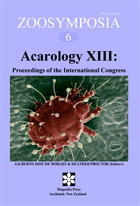Abstract
Anatomy and ultrastructural organization of the larval mouthparts in representatives of terrestrial (Trombiculidae parasitizing vertebrates and Microtrombidiidae parasitizing arthropods) as well as aquatic (Pionidae and Hydrodromidae parasitizing arthropods) families from the cohort Parasitengona were studied using whole-mount preparations, semi-thin sections and TEM and SEM methods. In these groups, the organization of the mouth apparatus differs significantly especially with regard to their particular functional specialization and adaptations reflecting evolutionary trends in these groups. In trombiculid larvae, the mouthparts reveal the simplest organization. The gnathosoma is totally free, the infracapitulum and the basal cheliceral segments are short and wide, and the latter are separated from each other. The flexible lateral lips form a temporary sucker, distinguishable when the larva feeds, and the pharynx is totally fused with the bottom of the infracapitulum. In microtrombidiid larvae, the gnathosoma is covered by the arched dorsal shield, the chelicerae are comparatively long and separated, and the lateral lips form a permanent sucker provided with an internal sclerite. Conversely, in water mite larvae, the chelicerae are fused together and either partially (Piona carnea) or totally (Hydrodroma despiciens) free from the overhanging idiosomal fold. The lateral lips are flexible and organized freely, and the pharynx is totally separated from the bottom of the infracapitulum. In general, water mite larvae show significant variations and specializations but at the same time seem to possess the most plesiomorphic characters in organization of the mouth apparatus. The ancestral parasitengone may have given rise to divergent groups of water mites as such, as well as to trombiculids with the secondary simplification of the mouth apparatus and to microtrombidiids with their particular additional adaptations and specialization in organization of the mouthparts.

